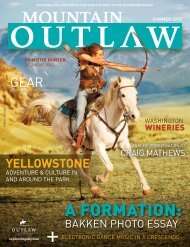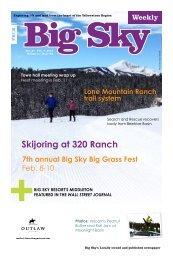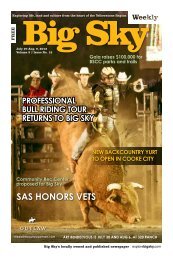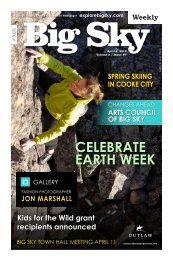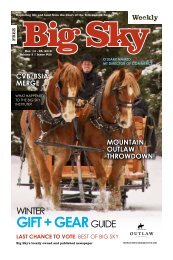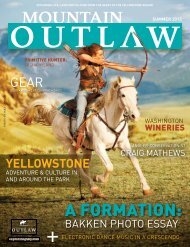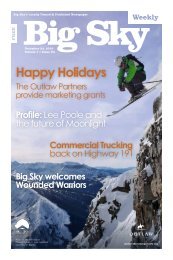HEALTH Strings Under the Big Sky - Explore Big Sky
HEALTH Strings Under the Big Sky - Explore Big Sky
HEALTH Strings Under the Big Sky - Explore Big Sky
Create successful ePaper yourself
Turn your PDF publications into a flip-book with our unique Google optimized e-Paper software.
egional<br />
explorebigsky.com<br />
<strong>Sky</strong>line Bus system adds new service to West Yellowstone<br />
summer schedule began June 18<br />
by emily stiFler<br />
big <strong>Sky</strong> weekly managing editor<br />
BIG SKY, BOZEMAN, WEST YEL-<br />
LOWSTONE – After several years of<br />
planning and collaboration, <strong>the</strong> <strong>Sky</strong>line<br />
Bus system is expanding to include a<br />
route from Bozeman to West Yellowstone.<br />
The new service is set to begin<br />
in July.<br />
“It was a gap in service to and around<br />
Yellowstone National Park,” said <strong>Sky</strong>line’s<br />
regional coordinator David Kack.<br />
The Montana Department of Transportation<br />
agreed to put $75,000 toward <strong>the</strong><br />
service for fiscal year 2013, and <strong>Sky</strong>line<br />
is now finalizing <strong>the</strong> details on that<br />
contract.<br />
The <strong>Big</strong> <strong>Sky</strong> Resort Tax board in June<br />
agreed to fund $300,000, which will<br />
go primarily go to <strong>the</strong> ongoing services<br />
in <strong>Big</strong> <strong>Sky</strong> and between <strong>Big</strong> <strong>Sky</strong> and<br />
Bozeman.<br />
<strong>Sky</strong>line also requested $30,000 from<br />
Gallatin County, which <strong>the</strong> county<br />
commission voted against in an initial<br />
budget vote in June. This decision<br />
was an “issue of budgetary priorities,<br />
said Commission Chairman Steve<br />
White. The commission, which votes<br />
on its final budget in August, has<br />
never supported <strong>Sky</strong>line fiscally.<br />
Regardless, Kack said, “we want to<br />
get <strong>the</strong> service [to West] out on <strong>the</strong><br />
street. We don't want to wait until<br />
August when <strong>the</strong> county may or may<br />
not provide any support.”<br />
<strong>Sky</strong>line also requested $5,000 from<br />
West Yellowstone, and also asked<br />
its town council to send a letter to<br />
Gallatin County asking it to support<br />
<strong>the</strong> service.<br />
<strong>Sky</strong>line is part of <strong>the</strong> Linx bus system,<br />
which is a transportation cooperative<br />
that works with 20 providers<br />
in <strong>the</strong> Greater Yellowstone region and<br />
also runs busses into <strong>the</strong> park itself.<br />
“Our goal is to improve connectivity<br />
using existing systems already in<br />
place,” said Linx Field Representative<br />
from West Yellowstone, Kimberly<br />
Brown. This new service allows just<br />
that.<br />
Linx’s summer operation center is in<br />
West, and Brown says of <strong>the</strong> most<br />
popular requests is from people flying<br />
into Bozeman who want to get to<br />
West so <strong>the</strong>y can see <strong>the</strong> park.<br />
Riders could use this new service to<br />
connect to ano<strong>the</strong>r carrier in West<br />
and ride into Yellowstone Park, to<br />
Jackson, Pocatello, Salt Lake City, or<br />
o<strong>the</strong>r spots around <strong>the</strong> region.<br />
The service will also compliment an<br />
existing one provided by <strong>the</strong> West<br />
Yellowstone Foundation, which offers<br />
rides around West and up to Bozeman<br />
three days a week. While that<br />
service is geared mainly for residents<br />
of West to get to Bozeman for medical<br />
appointments or shopping, Kack says<br />
<strong>Sky</strong>line is meant more to get people<br />
to West. And he notes, it’s 365 days<br />
a year.<br />
Wildfire Season: Spring somewhat similar to 1988<br />
more than 30,000 acres burning<br />
by emily stiFler<br />
big <strong>Sky</strong> weekly managing editor<br />
BOZEMAN – Predictions for an average<br />
wildfire season may soon go up<br />
in smoke, as more than 30,000 acres<br />
were already burning in southwest<br />
and south-central Montana in late<br />
July. Gov. Brian Schweitzer on June 26<br />
announced a state of emergency Lewis<br />
and Clark, Broadwater, Jefferson and<br />
Madison counties.<br />
When <strong>the</strong> Weekly went to press on<br />
Wed June 27, three fires were burning<br />
in southwest Montana: <strong>the</strong> 14,770-acre<br />
Beartrap 2 Fire along <strong>the</strong> Madison River<br />
near Norris; <strong>the</strong> 6,400-acre Pony Fire<br />
in <strong>the</strong> Tobacco Root Mountains west of<br />
Pony, and <strong>the</strong> 686-acre Antelope Lane<br />
Fire, in <strong>the</strong> Bull Mountains north of<br />
Whitehall.<br />
The Corral Fire was also burning 1,200<br />
acres in <strong>the</strong> Scratchgravel Hills, outside<br />
of Helena, and <strong>the</strong> Dahl Fire was<br />
burning 18,751 acres in Musselshell<br />
County.<br />
More than 500 firefighters from volunteer,<br />
county, state and regional crews<br />
were already working on <strong>the</strong> Pony,<br />
Beartrap and Antelope fires, combined.<br />
More were on <strong>the</strong> way, but were slow<br />
in arriving because many had been on<br />
assignment in o<strong>the</strong>r parts of <strong>the</strong> West.<br />
record breaking march heat<br />
(from earthobservatory.nasa.gov/iotd/view.php?id=77465)<br />
The previous few days had seen<br />
winds sustained at 20 miles an hour<br />
with gusts up to 50. Combined with<br />
temperatures in <strong>the</strong> high 90s and dry<br />
fuels, it was “a recipe for very intense<br />
fire behavior,” said Terina Mullen a<br />
fire mitigation and education specialist<br />
from <strong>the</strong> Western Montana District<br />
BLM Office.<br />
The winds also hampered firefighting<br />
efforts, grounded aircraft, and on June<br />
25, caused <strong>the</strong> Beartrap 2 Fire to jump<br />
<strong>the</strong> Madison River and cross Highway<br />
84.<br />
As of press time, <strong>the</strong> Beartrap 2 and<br />
Pony fires were not contained at all, and<br />
<strong>the</strong> Antelope Lane Fire was 40 percent<br />
contained. Highway 84 was closed<br />
briefly, as were all BLM facilities on <strong>the</strong><br />
Madison River.<br />
The Bear Trap 2 Fire was caused by fireworks,<br />
<strong>the</strong> Antelope Lane by lighting,<br />
and <strong>the</strong> o<strong>the</strong>rs all unknown.<br />
Residents of <strong>the</strong> South Boulder River<br />
above <strong>the</strong> Indiana University Field Station<br />
in <strong>the</strong> Tobacco Roots were evacuated,<br />
and <strong>the</strong> Pony Fire had already<br />
burned two structures <strong>the</strong>re. Evacuations<br />
were also in effect for Blacks Ford<br />
south to Norris, and two structures had<br />
also been burned by <strong>the</strong> Beartrap 2 Fire.<br />
This level of fire activity isn’t typical<br />
for this time of year, Mullen said.<br />
explorebigsky.com<br />
<strong>Big</strong> <strong>Sky</strong> Weekly<br />
<strong>Sky</strong>line has been in service for five<br />
years. With more than 60,000 people<br />
using <strong>the</strong> Bozeman – <strong>Big</strong> <strong>Sky</strong> service in<br />
<strong>the</strong> last year, <strong>the</strong> number of people riding<br />
<strong>Sky</strong>line is up from its previous high<br />
of 47,449. Ridership on <strong>the</strong> service<br />
within <strong>Big</strong> <strong>Sky</strong> has also increased by<br />
about 8.5 percent over last year.<br />
<strong>Sky</strong>line’s summer schedule began Monday,<br />
June 18 and will run through Sept.<br />
9. The schedule offers two Canyon –<br />
Mountain Routes for rides around <strong>Big</strong><br />
<strong>Sky</strong>, and three round trips per day on<br />
<strong>the</strong> Link Express for rides between Bozeman<br />
and <strong>Big</strong> <strong>Sky</strong>. Demand response<br />
service is also available in <strong>Big</strong> <strong>Sky</strong>. Busses<br />
operate seven days a week.<br />
While <strong>the</strong> <strong>Sky</strong>line service within <strong>Big</strong><br />
<strong>Sky</strong> is free, a small fare is charged on <strong>the</strong><br />
service between <strong>Big</strong> <strong>Sky</strong> and Bozeman,<br />
and will be charged for <strong>the</strong> ride between<br />
Bozeman and West.<br />
skylinebus.com<br />
linx.coop<br />
Although <strong>the</strong> region had an average<br />
snowpack as of April 1, a warm spring<br />
caused <strong>the</strong> snowpack to melt faster. As<br />
forests dry out faster, fire risk increases<br />
earlier, said research ecologist Greg<br />
Pederson with <strong>the</strong> Nor<strong>the</strong>rn Rocky<br />
Mountain Science Center in Bozeman.<br />
“Even though we did alright for spring<br />
moisture it doesn't seem to have been<br />
enough to decrease fire risks substantially<br />
into <strong>the</strong> early summer,” Pederson<br />
said. “As soon as you shut off <strong>the</strong><br />
precipitation and get a wave train of<br />
days above 80 and 90 degrees with<br />
high winds, it can dry out really fast,”<br />
Pederson said.<br />
“We have a setup right now, climatically…<br />
that is similar in some ways to<br />
1988,” Pederson said, referring to <strong>the</strong><br />
year that fires burned nearly 1.2 million<br />
acres in and around Yellowstone Park.<br />
“Early high pressure systems that block<br />
precipitation, also lead to warm spring<br />
temperatures, and early snow melt out.<br />
Preconditioning <strong>the</strong> region to a long hot<br />
summer with dry soils, raising fire risk<br />
because forests are dry and flammable.”<br />
Across <strong>the</strong> Western U.S. this March,<br />
temperatures were between 12 and<br />
15 degrees C above <strong>the</strong> 20th century<br />
monthly average for March, Pederson<br />
added. “Basically with <strong>the</strong> warm and<br />
early spring, we had a perfect setup for a<br />
big fire and low streamflow year across<br />
<strong>the</strong> West.”<br />
June 29, 2012 13



